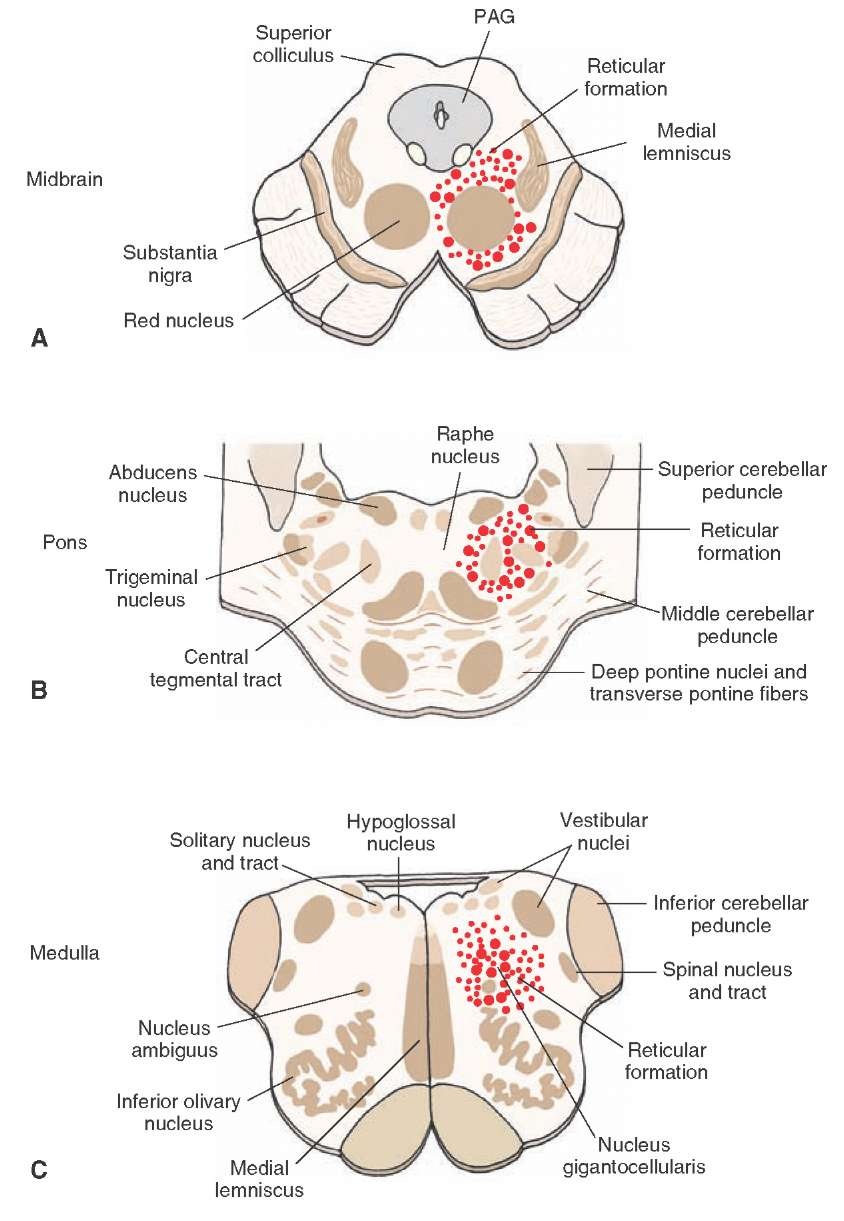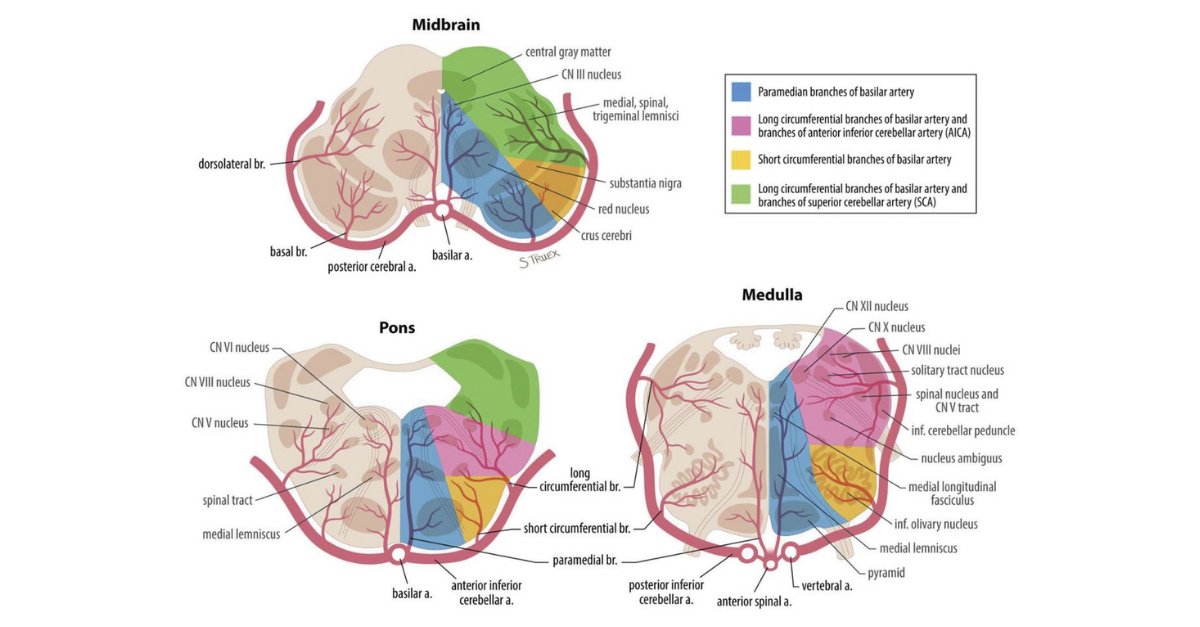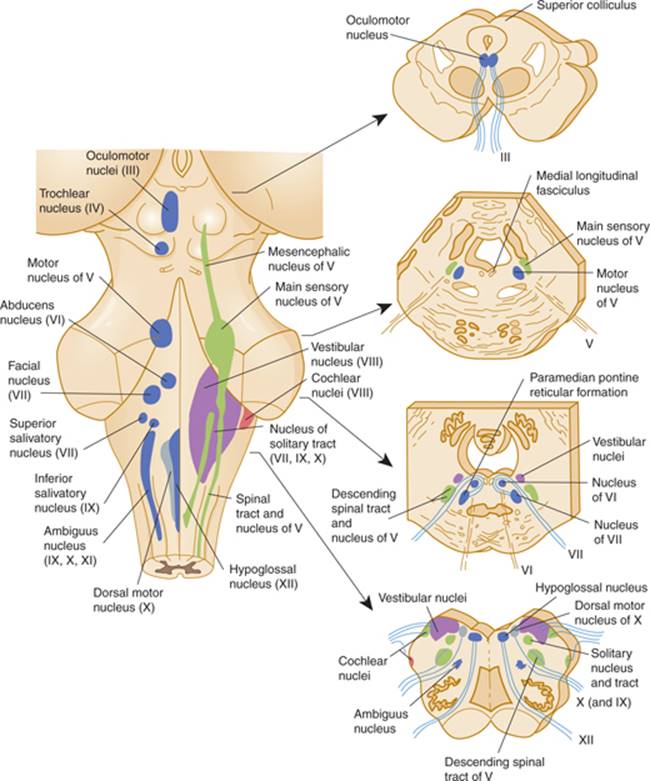Makindo Medical Notes"One small step for man, one large step for Makindo" |

|
|---|---|
| Download all this content in the Apps now Android App and Apple iPhone/Pad App | |
| MEDICAL DISCLAIMER: The contents are under continuing development and improvements and despite all efforts may contain errors of omission or fact. This is not to be used for the assessment, diagnosis, or management of patients. It should not be regarded as medical advice by healthcare workers or laypeople. It is for educational purposes only. Please adhere to your local protocols. Use the BNF for drug information. If you are unwell please seek urgent healthcare advice. If you do not accept this then please do not use the website. Makindo Ltd. | |
Brainstem anatomy and physiology and disease
-
| About | Anaesthetics and Critical Care | Anatomy | Biochemistry | Cardiology | Clinical Cases | CompSci | Crib | Dermatology | Differentials | Drugs | ENT | Electrocardiogram | Embryology | Emergency Medicine | Endocrinology | Ethics | Foundation Doctors | Gastroenterology | General Information | General Practice | Genetics | Geriatric Medicine | Guidelines | Haematology | Hepatology | Immunology | Infectious Diseases | Infographic | Investigations | Lists | Microbiology | Miscellaneous | Nephrology | Neuroanatomy | Neurology | Nutrition | OSCE | Obstetrics Gynaecology | Oncology | Ophthalmology | Oral Medicine and Dentistry | Paediatrics | Palliative | Pathology | Pharmacology | Physiology | Procedures | Psychiatry | Radiology | Respiratory | Resuscitation | Rheumatology | Statistics and Research | Stroke | Surgery | Toxicology | Trauma and Orthopaedics | Twitter | Urology
Related Subjects: |Cardiac Physiology |Renal Physiology |Pulmonary Physiology |Pancreas Physiology |Spleen Physiology |Gastrointestinal tract Physiology |Brainstem Physiology
The brainstem is a vital structure that connects the brain to the spinal cord. It controls many basic life functions, including breathing, heart rate, and blood pressure. The brainstem is divided into three main parts: the midbrain, pons, and medulla oblongata.
Parts of the Brainstem

- Midbrain (Mesencephalon):
- Located at the top of the brainstem, just below the thalamus and hypothalamus.
- Contains important structures such as the tectum, tegmentum, and cerebral peduncles.
- Tectum:
- Consists of the superior and inferior colliculi.
- Superior colliculi are involved in visual processing and eye movements.
- Inferior colliculi are involved in auditory processing.
- Tegmentum:
- Contains the red nucleus and the substantia nigra.
- Red nucleus is involved in motor coordination.
- Substantia nigra is part of the basal ganglia system and plays a role in reward and movement; degeneration here is associated with Parkinson's disease.
- Cerebral Peduncles:
- Large bundles of nerve fibers that connect the forebrain to the hindbrain.
- Contain motor tracts that run from the cerebral cortex to the pons and spinal cord.
- Pons:
- Located between the midbrain and the medulla oblongata.
- Serves as a bridge connecting different parts of the brain, particularly the cerebellum with the rest of the brain.
- Contains nuclei that are involved in the regulation of breathing, sleep, and arousal.
- Houses the trigeminal nerve (V), abducens nerve (VI), facial nerve (VII), and part of the vestibulocochlear nerve (VIII).
- Medulla Oblongata:
- Located at the base of the brainstem, just above the spinal cord.
- Controls vital autonomic functions such as heart rate, blood pressure, and respiration.
- Contains several important nuclei:
- Cardiovascular Center: Regulates heart rate and blood pressure.
- Respiratory Center: Controls the rate and depth of breathing.
- Reflex Centers: Mediate reflexes such as coughing, sneezing, swallowing, and vomiting.
- Houses the glossopharyngeal nerve (IX), vagus nerve (X), accessory nerve (XI), and hypoglossal nerve (XII).
Functions of the Brainstem
- Autonomic Control:
- Regulates autonomic functions such as heart rate, blood pressure, and breathing.
- Relay of Motor and Sensory Information:
- Acts as a conduit for sensory and motor pathways running between the brain and spinal cord.
- Coordinates and modulates sensory and motor activities.
- Cranial Nerve Functions:
- Contains nuclei for several cranial nerves that control functions such as facial sensation, hearing, taste, and eye movement.
- Regulation of Sleep and Wakefulness:
- Involved in the control of sleep cycles and wakefulness.
Clinical Relevance
- Brainstem Stroke:
- Disruption of blood flow to the brainstem can result in severe deficits or death.
- Symptoms: Sudden dizziness, difficulty swallowing, slurred speech, and loss of coordination.
- Parkinson's Disease:
- Degeneration of dopaminergic neurons in the substantia nigra of the midbrain.
- Symptoms: Tremors, rigidity, bradykinesia, and postural instability.
- Locked-In Syndrome:
- Damage to the pons resulting in quadriplegia and the inability to speak while consciousness and cognitive function remain intact.
- Medullary Respiratory Center Dysfunction:
- Damage to the medulla oblongata can lead to respiratory failure and require mechanical ventilation.
Key Cranial Nerve Nuclei in the Brainstem
- Midbrain: Cranial nerves III (oculomotor) and IV (trochlear) nuclei.
- Pons: Cranial nerves V (trigeminal), VI (abducens), VII (facial), and VIII (vestibulocochlear) nuclei.
- Medulla: Cranial nerves IX (glossopharyngeal), X (vagus), XI (accessory), and XII (hypoglossal) nuclei.

Blood Supply of the Brainstem
- Vertebral Arteries: The brainstem is primarily supplied by the vertebrobasilar system. The vertebral arteries fuse to form the basilar artery, which supplies blood to the brainstem.
- Basilar Artery: Provides branches such as the anterior inferior cerebellar artery (AICA), posterior inferior cerebellar artery (PICA), and superior cerebellar artery (SCA), which supply the brainstem and cerebellum.

Physiology of the Brainstem
The brainstem is involved in vital autonomic and sensory-motor functions. It controls fundamental processes necessary for survival and mediates the actions of the cranial nerves.
Functions of the Brainstem
- Autonomic Regulation: The medulla oblongata controls cardiovascular and respiratory functions. It regulates heart rate, blood pressure, and breathing by processing signals from baroreceptors and chemoreceptors.
- Motor Control: The brainstem contains motor tracts (e.g., corticospinal tract) that control voluntary movements, as well as nuclei involved in reflexes and muscle tone.
- Sensory Pathways: Sensory information such as touch, temperature, and pain passes through the brainstem via ascending pathways (e.g., spinothalamic tract, dorsal columns) before reaching the thalamus and cortex.
- Cranial Nerve Function: The brainstem houses the nuclei of most cranial nerves, controlling sensory and motor functions of the head and neck (e.g., eye movement, facial expression, hearing, taste, swallowing).
- Consciousness and Sleep-Wake Cycle: The brainstem contains the reticular activating system (RAS), which regulates wakefulness, arousal, and attention. It plays a key role in sleep and consciousness.
- Reflexes: The brainstem controls important reflexes such as swallowing, gagging, coughing, and sneezing.
Common Diseases and Disorders of the Brainstem
- Stroke (Brainstem Stroke): A brainstem stroke can cause serious deficits such as loss of consciousness, difficulty breathing, paralysis, and cranial nerve palsies. Symptoms depend on which part of the brainstem is affected (e.g., Wallenberg syndrome with PICA infarct).
- Locked-In Syndrome: Caused by damage to the pons, usually due to stroke. Patients are conscious but cannot move or speak, except for vertical eye movements and blinking.
- Medullary Syndrome (Wallenberg Syndrome): A condition resulting from a stroke in the lateral medulla, leading to symptoms such as vertigo, dysphagia, hoarseness, and loss of pain and temperature sensation on one side of the face and the opposite side of the body.
- Decerebrate and Decorticate Posturing: These are abnormal postures that occur due to severe brainstem or cortical damage. Decerebrate posturing involves extension of the arms and legs, while decorticate posturing involves flexion of the arms and extension of the legs.
- Parkinson's Disease: A neurodegenerative disorder that affects the substantia nigra of the midbrain, leading to tremors, rigidity, bradykinesia (slowness of movement), and postural instability.
- Multiple Sclerosis (MS): A demyelinating disease that can affect the brainstem, leading to symptoms such as double vision, facial weakness, vertigo, and dysphagia (difficulty swallowing).
- Brainstem Tumors: Tumors in the brainstem can cause symptoms like cranial nerve palsies, ataxia, weakness, and changes in breathing or heart rate. These tumours may be primary (e.g., gliomas) or metastatic.
- Chiari Malformation: A structural defect where brain tissue extends into the spinal canal, often compressing the brainstem and causing symptoms such as headaches, dizziness, and coordination problems.
- Brainstem Death: Refers to the irreversible loss of all brainstem function, including the ability to breathe and maintain cardiovascular regulation. It is one of the key criteria for declaring brain death.
Clinical Tests for Brainstem Function
- Reflexes: Testing reflexes such as the corneal reflex (blink reflex), gag reflex, and pupillary light reflex helps assess brainstem integrity.
- Vestibulo-Ocular Reflex (VOR): Assesses the brainstem's ability to coordinate eye movements with head movements.
- Motor and Sensory Testing: Motor strength and sensory evaluation in areas supplied by cranial nerves (e.g., facial movements, tongue movements) help assess brainstem function.
Summary
The brainstem is a critical structure connecting the brain to the spinal cord and regulating many vital functions. Its three main parts—the midbrain, pons, and medulla oblongata—coordinate activities such as autonomic control, motor and sensory relay, and cranial nerve functions. Understanding its anatomy and functions is essential for diagnosing and treating brainstem-related disorders.